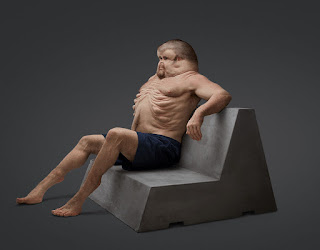Exercise 4.2 - Travels in Hyperidentity
Context:
"Titled "Bodies in Space," it will consider how the body is mediated by both virtual and physical space. The first section, "Radical Identification: The Body Online," is guided in part by a reading of Laura Mulvey's "Visual Pleasure and Narrative Cinema" and convenes artists who seek radical sources of personal or sexual identification in the internet age: Bunny Rogers's self-portraits as a mop or cat urn, Ann Hirsch's retelling of her preteen online relationship with an older man, or Laurie Simmons's photographs of the "doller" subculture. The second section, "The Body in Public," focuses on the organization of the body in public space and focuses on Magali Reus's custom-produced stadium seating, Alice Channer's floppy clothing cast in aluminum, and Nicolas Deshayes's slightly skewed public interior architecture. Lastly, the work of AIDS-3D, which often considers how corporate studies effect interior architecture (such as buffet sneezeguards), leads into the text's final section, "Corporate Bodies," which considers more directly the dissolving of offline and online binaries via a reading of Tiziana Terranova's 2004 book Network Culture: Politics for the Information Age, proffering instead the idea that information embodies most everything around us, and that offline/online binaries seem redundant in an age in which everything can be seen as a product of data.
"There are artists who consider technology, and how it can serve as an ex-tension of the body, in an investigative rather than critical light."
I liked the thought process of considering technology as an extension of one's own body concerning an investigative means. Technology granted humans this omniscient ability to really find an answer to any question with a google search alone. Being granted the ability to find any informative concept can also surprisingly be a deterrent to most. Looking at concepts like the paradox of choice, having this overwhelming amount of information could be seen as a negative to an individual's motivational levels and or their ability to manage their own time. After searching for something, most are unaware of just how much information is given by a simple google search (or even if the sources they find the information on is respectable/reliable). However, the ability to perceive technological advantages like informative searching is something humans have adapted as an extension of one's own body. This also holds true for a camera, screenshots, or any other means of photography. Much like how a soldier is taught that their gun is an extension of their arm, or how a tennis play is taught that when they pick up their rackets, it becomes a part of their body. The photographer should see their camera as an extension of their eyes.
When Alice Channer's mentioned bodily alienation, the first concept that came to mind was of changing one's self to avoid an aspect of this awkwardness, body manipulation/altercation is done through many different means like tattoos, Botox, or piercings. By today's standards, it is predominantly done through a virtual means. Photoshop being the supreme example of individuals forming a mild form of body dysmorphia and changing their appearance to something more appealing in their own eyes. Who are we or how do we see ourselves? Are we aspects of nature that shouldn't be tampered with? Or should we be allowed to change our physical form according to our wishes and desires? With regards to photography, we have seen how things like photoshop can take on extreme body manipulation as people change the physicality of their face structurally or manipulate their body to fit the standards or "expectations" of things like WHR (waist to hip ratio).
But we can also see how social media platforms like Instagram "expose" how the majority of individuals are not as perfect as their profile pictures seem when compared to a "natural" or truly candid photo of them is published.
Diptychs like the one above of Mila Kunis border more on the side of harassment; The fact that people tend to call attention to women when they aren't wearing makeup should be sickening. The choice to cake up one's face is his or her own. I genuinely wish that the invention of composition didn't become so mainstream that it seemingly has become an unwritten rule for societal norms. An individual's true beauty resides with their natural look and not beneath pounds of foundation. The choice of avoiding a natural look and instead of layering on a multitude of different kinds of makeup truly embodies hiding behind a mask and one's idealistic image of themselves. However, there is a significant distinction between consistently changing your outward appearance daily and having a poor photo taken of one's self. Each individual has a unique perspective on what their best angle is. From a psychological perspective, people tend to find the left side of a person's face more appealing than the right (hypothesized to mainly be attributed to the contralateral fashion with the way our occipital lobe is connected with our left and right hemisphere). Regardless of what your best angle is, everyone has one, and somewhat more importantly, we all have way more bad angles/emotional facial expressions that good.
Posture, emotional expressions, high versus low angles, additives can all improve someone's photo as well. And obviously, this is not restricted by sex; men are hyper-masculinized as well.
Alice Channer's' "Material awkwardness" or binary, continually referencing the absent (not necessarily human) body. Even though her work is entirely different as she deflates clothes, stretches body parts, casts the flimsy in aluminum, and renders liquid as stable. I believe when she describes her work as a "figurative sculpture without a body," it can be said about photoshop as well. Photoshop would be a poor example of a way we adapt to Alice Channer's' philosophy of constantly feeling in a state of awkwardness as we try and fix what we perceive as awkward.

Comments
Post a Comment